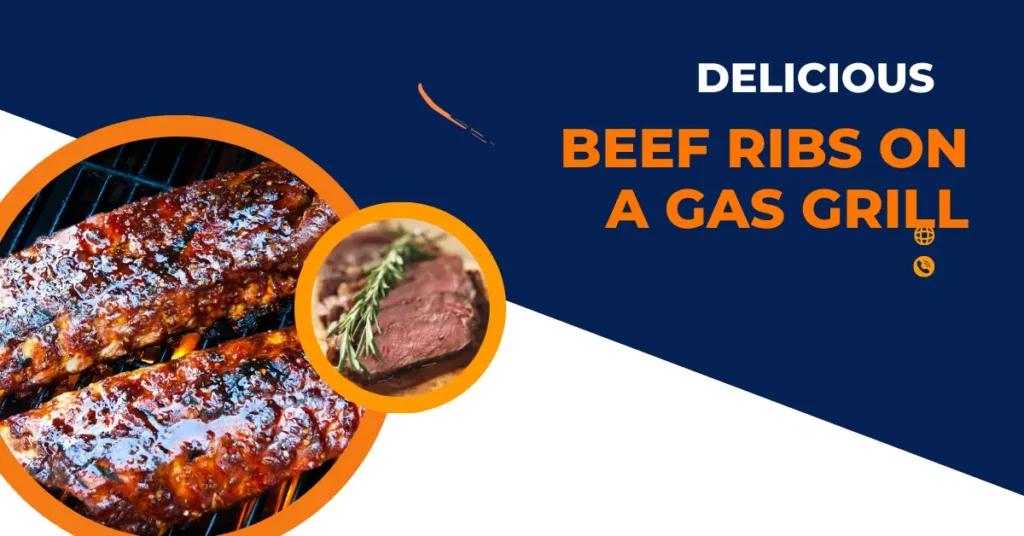This post may contain affiliate links. If you use these links to buy something we may earn a small commission. Thanks.
Beef ribs are a quintessential barbecue favorite, boasting rich flavors and tender meat that falls off the bone when cooked just right. While many assume that mastering beef ribs requires a charcoal grill or smoker, a gas grill can achieve equally mouthwatering results. In this guide, we’ll walk you through how to BBQ beef ribs on a gas grill, ensuring they turn out smoky, juicy, and flavorful.
Types of Beef Ribs
Before diving into the cooking process, it’s essential to understand the two main types of beef ribs:
- Short Ribs: These are meatier and cut from the plate section of the cow. They’re ideal for slow cooking and can be incredibly tender when prepared correctly.
- Back Ribs: These come from the rib section near the spine and are generally less meaty but boast a rich, beefy flavor. Back ribs are often favored for grilling.
When choosing beef ribs, look for racks with good marbling (visible fat within the meat), as this ensures flavor and tenderness. Avoid racks with too much surface fat or those that appear dry.
Preparing the Rib
Trimming the Ribs
Start by trimming any excess fat from the ribs. You’ll also want to remove the silver skin—a thin, tough membrane on the bone side of the ribs. Use a sharp knife to lift the edge of the membrane, then grab it with a paper towel for a better grip and pull it off in one motion.

Seasoning the Ribs
Seasoning is where you can infuse the ribs with flavor. You can choose between a dry rub or a wet marinade:
- Dry Rub: This method creates a crusty bark packed with flavor. A simple dry rub recipe includes:
- 2 tablespoons kosher salt
- 2 tablespoons black pepper
- 1 tablespoon smoked paprika
- 1 tablespoon garlic powder
- 1 tablespoon onion powder
- 1 tablespoon brown sugar
- Wet Marinade: If you prefer, you can marinate the ribs overnight in a mixture of soy sauce, Worcestershire sauce, garlic, and spices for deeper penetration of flavors.
Allow the ribs to sit with the seasoning for at least 1–2 hours, or refrigerate overnight for maximum flavor absorption.
Preparing the Gas Grill
To replicate the low-and-slow cooking method typical of smokers, set up your gas grill for indirect grilling.
- Clean the Grill Grates: Use a grill brush to clean the grates thoroughly, ensuring the ribs won’t stick.
- Set Up Two-Zone Cooking:
- Turn on one or two burners to create a direct heat zone.
- Leave the other burners off to create an indirect heat zone.
- Preheat the Grill: Aim for a temperature of 225°F–250°F. This low temperature allows the ribs to cook slowly, breaking down the connective tissues and rendering them tender.
- Add Smoke Flavor: Place a smoker box or a foil packet filled with wood chips (such as hickory, mesquite, or applewood) over the direct heat. This adds the signature smoky flavor to your ribs.
Cooking the Ribs
Step 1: Searing the Ribs (Optional)
While not necessary, a quick sear over direct heat can create a flavorful crust. Place the ribs bone-side down on the direct heat for 1–2 minutes, then flip and sear the meaty side for another 1–2 minutes. Move the ribs to the indirect heat zone after searing.
Step 2: Slow Cooking
Position the ribs bone-side down on the indirect heat zone of the grill. Close the lid to maintain a consistent temperature. Cook the ribs low and slow for 3–4 hours. Check the grill temperature periodically to ensure it remains steady between 225°F and 250°F.
Step 3: Basting the Ribs (Optional)
If you enjoy saucy ribs, baste them with your favorite BBQ sauce during the final 30 minutes of cooking. Apply the sauce generously with a brush, letting it caramelize without burning.
Checking for Doneness
There are two reliable ways to determine if your beef ribs are done:
- Internal Temperature: Use a meat thermometer to check the internal temperature of the ribs. They should reach 200°F–205°F for optimal tenderness.
- Visual and Physical Cues:
- The meat will pull back from the bones, exposing about half an inch of bone.
- Pick up the rack with tongs and perform the “bend test”—the rack should bend easily and the meat should begin to crack.
Resting and Serving
Once the ribs are done, remove them from the grill and let them rest for 10–15 minutes. This step allows the juices to redistribute, ensuring every bite is moist and flavorful. After resting, slice the ribs between the bones and serve.
Pair your BBQ beef ribs with classic sides like coleslaw, baked beans, cornbread, or grilled vegetables for a complete meal.
Pro Tips for Perfect Beef Ribs
- Maintain a Steady Temperature: Fluctuating temperatures can lead to uneven cooking. Check the grill’s thermometer often.
- Use a Drip Pan: Place a drip pan under the ribs to catch fat drippings and prevent flare-ups.
- Don’t Rush: Low and slow is key to tender, flavorful ribs. Avoid the temptation to turn up the heat to speed up the process.
- Experiment with Flavors: Try different wood chips, rubs, and sauces to discover your signature style.
Conclusion
Grilling beef ribs on a gas grill might seem intimidating, but with the right preparation and techniques, you can achieve smoky, tender ribs that rival those from a traditional smoker. Follow this step-by-step guide, and you’ll be well on your way to mastering BBQ beef ribs that will impress family and friends. Happy grilling!
